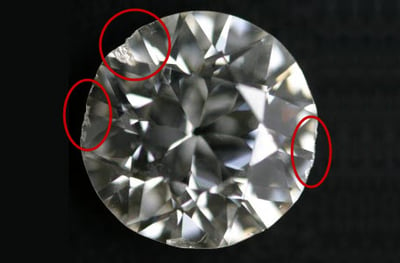
If you don’t have a relationship with a diamond cutter (someone who actually cuts diamonds), chances are you’re missing out on countless opportunities to realize additional revenue for your business. Hidden in your safe or stashed away at the back of your drawer are the lesser diamonds, which you’ve taken in over the years. They may be chipped, scratched, burnt or broken - damaged goods in dire need of repair. More than likely, you have thousands of dollars tied up in diamond inventory that you aren’t able (or prepared) to show in their current condition.
So how do you sell these diamonds without a decent cut grade or trusted grading report, especially if you are known as the trusted source for fine diamonds in your market?
You can either sell them to a growing list of companies that specialize in the purchase of such goods (at greatly discounted prices), or you can find a cutter that you can work with and invest some time and money to turn this into inventory that you can present with confidence to any prospective customer.
Finding a Cutter
Finding the right cutter isn’t always about price. When researching to find a diamond cutter to work with, it is important to verify their credentials through their membership of organizations such as the American Gem Society, Independent Jewelers Organization, Jewelers of America or your regional jewelry organization. Most cutters have incentive programs in place for members of these organizations and should be able to provide you with references from their customers.
Most importantly, you can tell a lot about the quality of work you can expect from a cutter by their preferred diamond grading laboratory, as the various diamond cut grade standards differ.
Pricing Guidelines
You get what you pay for. If you’re looking for a cheap cutter, then be prepared to ship the same stone back and forth, consequently paying more in the long run. There are plenty cheap cutters out there, but if you’ve taken the time to read this article, you’re committed to the finest quality and craftsmanship.
What to consider when choosing a Cutter:
1. Most cutters will charge a different rate for round and fancy and proprietary shapes. Fancy shapes will normally cost you 25-50% more than round shapes and proprietary shapes may be subject to additional charges – be sure your cutter does not infringe on someone else’s design patent.
- For minor repairs and re-polish, expect to pay $150-$200/ct
- For full re-cuts including re-profiling, expect to pay $225-$300/ct
- For challenging stones (multiple twinning, poly), expect to pay an additional $75/ct
- For girdle faceting only, expect to pay $100/ct
2. Shipping & insurance will be for your account, and will vary according to the value of your shipments. Don’t forget that shipping diamonds to your preferred grading laboratory will add additional shipping and insurance costs.
3. Grading & inscription varies between the different grading laboratories and the documentation required. If you have a relationship with a grading laboratory, you should have their rate sheet on file. TIP: Always confirm the laboratory’s turn-around time.
What to consider when going through your inventory:
1. Size matters - Individual stones smaller than 0.3ct really are not economically viable, unless you’re prepared to submit a parcel of smalls and wait a little while longer. The golden rule is if it’s something you’re prepared to send for grading once finished, then it’s worth it. Remember, less is more. Most cutters will have a minimum cost per diamond for stones smaller than 1ct.
2. Safe (weight loss) margins:
- For non-broken/chipped/damaged diamonds sent for re-cutting, the weight loss can be up to 15%.
- For broken/chipped/damaged diamonds sent for re-cutting, the weight loss can be substantial.
- For diamonds sent for re-polishing the weight loss will be in the single digits.
3. A minor repair will typically involve some re-polishing to clean up the stone and possibly faceting the girdle (which may result in color gains on some borderline stones) - minor work to improve the overall cut-grade of a diamond.
Conclusion
I hope that this article has been valuable in helping you understand the benefits of diamond re-cutting and what you should look for, or should expect, when turning your loose diamond inventory into beautiful, resalable pieces that will catch the eyes of your customers and greatly increase your revenue.


 RapNet Blog
RapNet Blog